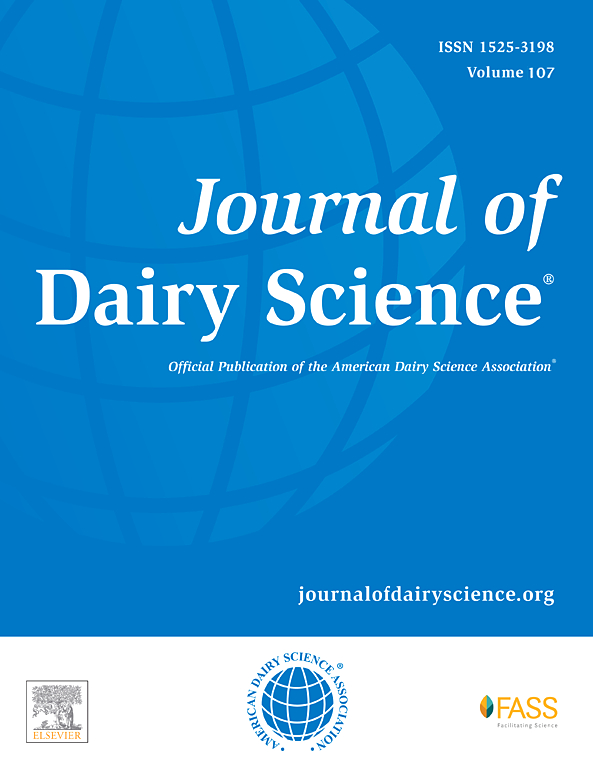荷斯坦-弗里斯兰牛孪生率及其与其他繁殖性状关系的基因组分析。
IF 3.7
1区 农林科学
Q1 AGRICULTURE, DAIRY & ANIMAL SCIENCE
引用次数: 0
摘要
奶牛双胎通常与奶牛的繁殖性能和犊牛存活率不利相关。在其他性状没有不良相关反应的前提下,通过遗传选择来降低奶牛的双胞胎率可能是可取的。本研究旨在描述爱尔兰荷斯坦-弗里斯兰种群中双胞胎率的基因组结构,并量化双胞胎与其他繁殖性状和产奶量之间的遗传关系。研究人员利用 1996 年至 2022 年的产犊记录和血统信息来估算双胞胎率的育种价值。利用 2,656 位荷斯坦-弗里斯兰种公牛的去回归育种值估计值,对孪生率、产仔间隔、奶牛存活率和首次产仔年龄进行了全基因组关联分析。所有种公牛的全基因组序列数据均来自约 50,000 个单核苷酸多态性。孪生率的遗传率为 0.0118 ± 0.0010。孪生率与产奶量(0.13)和繁殖性状(-0.26 至 0.14)的遗传相关性很弱。基因组分析发现,BTA11 上 31.1 Mb 处与孪生率有关,该处靠近卵泡刺激素受体和促黄体生成素-绒毛膜促性腺激素受体基因,这支持了之前的研究。该区域最重要的 SNP 与产奶量无关,这表明选择有可能降低双胞胎率,而不会对产奶量产生不利影响。还发现了与 BTA27 上初产犊年龄相关的新 SNP,以及来自 BTA29 上产犊间隔和初产犊年龄荟萃分析的新 SNP,这些都是未来验证和研究的候选SNP。本文章由计算机程序翻译,如有差异,请以英文原文为准。
A genomic analysis of twinning rate and its relationship with other reproductive traits in Holstein-Friesian cattle
Twin births in dairy cattle is generally unfavorably associated with reproductive performance and calf survival in dairy cows. Genetic selection to reduce twinning rate in dairy cattle may be desirable, provided no undesirable correlated responses in other traits exist. The current study was undertaken to characterize the genomic architecture of twinning rate in the Irish Holstein-Friesian population, and to quantify the genetic relationship of twinning with other reproductive traits and milk yield. Calving records from the years 1996 to 2022 were used together with pedigree information to generate breeding value estimates for twinning rate. Genome-wide association analyses of twinning rate, calving interval, cow survival and age at first calving were conducted using de-regressed breeding values estimates for 2,656 Holstein-Friesian sires. Full genome sequence data imputed from ∼50,000 single nucleotide polymorphisms were available for all sires. The h2 of twinning rate was 0.0118 ± 0.0010. Twinning rate was very weakly genetically correlated with both milk yield (0.13) and the reproductive traits (−0.26 to 0.14). Genomic analyses detected an association with twinning rate at 31.1 Mb on BTA11 in close proximity to genes for FSH receptor and luteinizing hormone-chorionic gonadotropin receptor, supporting previous studies. The most significant SNP in this region was not associated with milk yield, indicating the potential for selection to reduce twinning rate without detrimentally affecting milk yield. Novel SNP associations with age at first calving on BTA27 and from a meta-analysis of calving interval and age at first calving on BTA29 were also identified and are candidates for future validation and study.
求助全文
通过发布文献求助,成功后即可免费获取论文全文。
去求助
来源期刊

Journal of Dairy Science
农林科学-奶制品与动物科学
CiteScore
7.90
自引率
17.10%
发文量
784
审稿时长
4.2 months
期刊介绍:
The official journal of the American Dairy Science Association®, Journal of Dairy Science® (JDS) is the leading peer-reviewed general dairy research journal in the world. JDS readers represent education, industry, and government agencies in more than 70 countries with interests in biochemistry, breeding, economics, engineering, environment, food science, genetics, microbiology, nutrition, pathology, physiology, processing, public health, quality assurance, and sanitation.
 求助内容:
求助内容: 应助结果提醒方式:
应助结果提醒方式:


